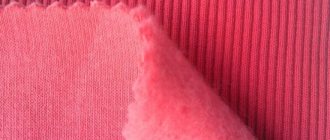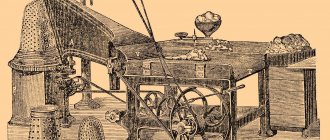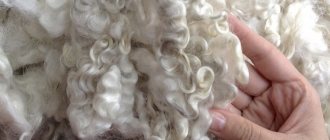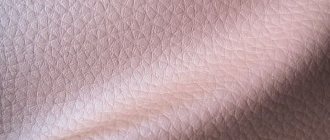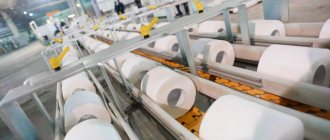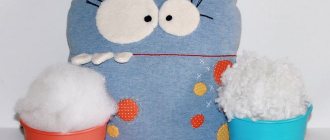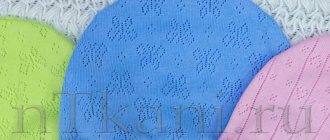Home / Fillers
Back
Published: 06/23/2021
Reading time: 4 min
0
7
In ancient times, sheep's wool was considered a gift from the gods. It was one of the first natural materials that protected humans from cold and disease. Today it has many synthetic and artificial analogues with a long series of positive qualities. But they all only imitate a product created by nature. It contains no toxins, because sheep, by their biology, ignore unnatural food and do not drink contaminated water. This is why wool is so valued as a raw material for clothing and bedding.
- 1 Extraction of raw materials and production
- 2 Classification of sheep wool and the best breeds
- 3 Material characteristics 3.1 Advantages
- 3.2 Disadvantages
Merinos, Dorpers and others
Scientists count dozens of sheep breeds. Some of them are intended for meat production, others are for wool.
How much wool does a sheep produce? Depending on the variety. For example, from a texel you can get up to 5 and a half kg for each clip, merino gives its owners up to 7 kilograms.
Very often you can hear such a name as “fleece”. Indeed, it is used as a characteristic of sheep wool. Fleece is a single layer when the fibers have not disintegrated.
What is another name for sheep's wool? Merino. This name comes from one of the wool breeds of such animals.
Fleece of different breeds will differ in type. There are braids - loose structure and staple - smooth, homogeneous. Why are they different in structure? Much depends on the germination of villi and their bonding, as well as density.
Semi-fine fleece
Such raw materials are obtained from sheep raised in mild, humid climates. These include:
- Tsigai breed;
- new Russian breeds;
- Romney-Marsh, Lincoln breeds from England.
This includes crosses between some fine-wool and coarse-wool breeds. Fiber thickness – from 26 to 40 microns.
Semi-coarse-haired
The fiber thickness of semi-coarse-haired breeds ranges from 41 to 60 microns. Raw materials with these parameters will be obtained from sheep raised in mountain conditions. These are rough-haired and some varieties of long-haired breeds. The fiber of these sheep is coarser than merino, but is durable and of sufficient length (20-25 microns). It is convenient to spin. Products made from such raw materials have a silky shine.
Rough-haired
The habitat of coarse-wool sheep breeds is deserts and semi-deserts. Coarse fiber is also obtained from meat and meat and dairy animals. The fiber thickness reaches 61 microns. The raw materials are used for the manufacture of outerwear, felt and carpets, which are durable.
How to determine fineness (degree of fineness)
Pieces are plucked from the fleece in different areas. Then the scraps are stretched until a mesh appears. Experts very carefully examine all sections of the staples and give opinions on the quality of the raw materials.
If you need to determine very precisely, you can contact a specialized laboratory. To determine their diameter, villi are examined and measured using a microscope.
Treatment
In production, sheep wool is processed using specialized devices and machines. The types of units depend on the types of raw materials.
If wool needs to be processed manually, there are several steps to go through:
- Smooth the raw material using a specialized comb to remove impurities and dirt.
- Dry the wool. This is done not only to remove moisture and grease, but also to eliminate odor. It is recommended to use special dryers.
- Wash and dry, it is also recommended to do this using special units.
The final stage is combing and leveling the structure. It is also advisable to beat the fleece with wooden rods to give it softness. Then you can use spinning machines to produce yarn.
Subtleties of processing at home
The wool processing process has undergone major changes in recent decades. In the 90s, Russian sheep farming fell into decline. The orderly fiber procurement system fell apart. The number of livestock fell sharply. Gradually, technologies for cultivating raw materials began to become a thing of the past.
Over time, the situation began to change for the better. Farms and peasant farms appeared. The need to process their own products forced villagers to remember the craft of the recent past.
Livestock breeders realized that selling wool immediately after shearing was unprofitable. Moreover, sheep farming has become a family business. In conditions of developed technologies, there is no need to talk about a full cycle of processing raw materials on site. Primary processing is justified and includes the following steps:
- Sorting. The process is tedious and responsible. Fibers even from the same animal differ in quality, length, and purity.
- Cleaning. Raw materials have to be cleaned of plant debris, pieces of manure and other unnecessary elements.
- Flushing. A mandatory procedure that makes the material presentable. Special products are used for washing. For every kg of raw material add 250-300 grams. powder. The washed wool is rinsed in hot water. The number of procedures depends on the degree of fiber contamination.
- Drying. The raw materials are laid out on a mesh in a thin layer. The thickness should not exceed 1.5 cm. Otherwise, the wool will take a long time to dry.
- Combing. This work is done in two ways. The most popular is the carding method, based on combing with brushes with fine bristles made of thin but elastic metal wires. The second method is called combing, but it is almost never used.
You can make yarn from the finished fiber with your own hands. Almost no one uses old spinning machines anymore. Electrically driven machines are used to produce high-quality thread.
Implementation
At the initial stages of activity, many breeders are interested in the question: where to donate sheep wool.
The products are transported to textile industry enterprises engaged in processing and creating interior items or clothing.
Since such industries are always short of raw materials, wool is bought quite willingly, especially if it is of high quality.
Another important question: how much does a kg of sheep’s wool cost? Depending on the breed of animals and the quality of the raw materials, as well as the correct haircut, enterprises accept raw materials at a price of 30 to 200 rubles per kilo.
Where is sheep wool used?
From various raw materials obtained after shearing, the following is made:
- Yarn.
- Things.
- Carpets.
- Pillows, blankets.
- Blankets, capes, bedspreads.
- Means used for medicinal purposes. For example, belts against radiculitis.
- Woolen fabrics.
- Shoes.
- Decorative elements.
For example, felt made from sheep wool is an excellent material that is used everywhere, both in the production of clothing and footwear, and in mechanical engineering and other production areas.
Extraction of raw materials and production
Shearing of raw materials is done manually. The work is performed by experienced craftsmen who are familiar with the process technology and follow safety precautions. For the initial treatment of wool, use a soap-soda solution, and clean water for rinsing. Afterwards the pressed fleece is dried. Sheep wool tends to curl and bend with the formation of “curls”. Thanks to microscales, fibers are bonded to form strong yarn and reliable insulating fabrics. The structure of the raw material is such that the spaces between the threads are filled with air. This feature simplifies the care of the material. Water easily enters these gaps and washes away dirt from there.
Important Features
There is almost never an allergy to sheep wool. Such products are not contraindicated even for asthmatics.
Hats, mittens, socks, blankets, and sweaters made of sheep wool have proven themselves very well in the conditions of Siberia and the Urals, where severe frosts are observed in winter.
Scientists note that when wearing items made from sheep wool, friction creates an electrostatic field. Due to its influence, therapeutic massage is carried out.
Scientists have calculated that people invented felt more than 8 thousand years ago. In addition, the fleece is quite fire resistant.
In addition, they discovered another important property: sheep’s wool periodically cleans itself, neutralizes unpleasant odors and even poisons.
The quality of wool largely depends on care. If the sheep are not looked after, the animals are not vaccinated, they are abandoned to their fate, and their wool quickly falls off.
When livestock is kept in proper conditions, cleanliness and care, the animals do not get sick, are healthy, clean, and the wool is of fairly high quality.
How are clothes made from sheep's wool?
People learned to make clothes from this material hundreds of thousands of years ago. If earlier these were simple capes made of poorly processed skins, now the most modern clothing samples are prepared from wool fiber.
The loom revolutionized the production of wool products. New technologies make it possible to create the finest threads for the manufacture of exquisite goods. Production processes are mainly automated and allow the production of products in huge quantities.
See also
What is the best name for a lamb, TOP 50 nicknames for girls and boysRead

